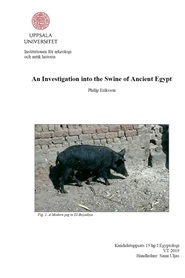
Свинското е част от основната диета на древните египтяни от най-дълбока древност: Преддинастичния период, чак до епохата на арабското завоевание, а отчасти запазва тази си роля дори и днес в средите на една от местните религиозни общности (коптите).
Въпреки това свинете се споменават крайно рядко в древноегипетските писмени паметници , също толкова спорадично е присъствието или по-скоро отсъствието им в изобразителното изкуство. При това в преобладаващия брой случаи те са обект с подчертано негативни конотации.
Настоящата любопитна курсова работа разглежда причините и съдържанието на тези явления от една мултидисциплинарна гледна точка: през призмата едновременно на икономиката, социологията и културната антропология. Според автора в Древен Египет не е съществувало религиозно или културно табу върху свинското месо. Единствената причина за пренебрежението към свинята е нейното асоцииране с низшите слоеве и оттам отбягването ѝ от елита по причини свързани най-вече със социалния статус.
Philip Eriksson - An Investigation into the Swine of Ancient Egypt, Uppsala, Uppsala University, 2019 - на английски език, от DiVa: Digitala Vetenskapliga Arkivet, формат PDF.Свалянето става с десен бутон (downloading by right button) и Save as...
| 
